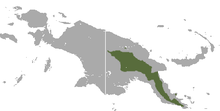Goodfellow's tree-kangaroo
| Goodfellow's tree-kangaroo | |
|---|---|
 |
|
| Scientific classification | |
| Kingdom: | Animalia |
| Phylum: | Chordata |
| Class: | Mammalia |
| Infraclass: | Marsupialia |
| Order: | Diprotodontia |
| Family: | Macropodidae |
| Genus: | Dendrolagus |
| Species: | D. goodfellowi |
| Binomial name | |
|
Dendrolagus goodfellowi Thomas, 1908 |
|
 |
|
| Goodfellow's tree-kangaroo range | |
Goodfellow's tree-kangaroo (Dendrolagus goodfellowi) also called the ornate tree-kangaroo, belongs to the family Macropodidae, which includes kangaroos, wallabies and their relatives, and the genus Dendrolagus, with eleven other species. The species is native to the rainforests of New Guinea, and the border of central Irian Jaya in Indonesia. Under the IUCN classification, the species is listed as Endangered, which is a result of overhunting and human encroachment on their habitat. It is named after British zoological collector Walter Goodfellow.
Like other tree-kangaroos, Goodfellow's tree-kangaroo is quite different in appearance from terrestrial kangaroos. Unlike its land dwelling cousins, its legs are not disproportionately large compared to its forelimbs which are strong and end in hooked claws for grasping tree limbs, and it has a long tail for balance. All of these features help it with a predominantly arboreal existence. Goodfellow's tree-kangaroo has short, woolly fur, usually chestnut to red-brown in color, a gray-brown face, yellow-colored cheeks and feet; a pale belly, a long, golden brown tail, and two golden stripes on its backside. It weighs approximately 7 kg (about 15 lb).
There are two subspecies of the Goodfellow's tree-kangaroo:
Goodfellow's tree-kangaroo is slow and clumsy on the ground, moving at about walking pace and hopping awkwardly, leaning its body far forward to balance the heavy tail. However, in trees it is bold and agile. It climbs by wrapping its forelimbs around the trunk of a tree and hopping with the powerful hind legs, allowing the forelimbs to slide. It has extraordinary jumping ability and has been known to jump to the ground from heights of 30 feet without ill effect.
Although it feeds mainly on the leaves of the Silkwood tree (Flindersia pimenteliana), other morsels are accepted when available, including various fruits, cereals, flowers and grasses. It has a large stomach that functions as a fermentation vat, similar to the stomachs of cows and other ruminant herbivores, where bacteria break down fibrous leaves and grasses.
...
Wikipedia

